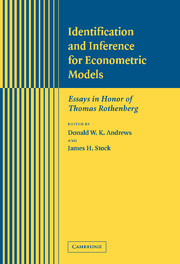Book contents
- Frontmatter
- Contents
- List of Contributors
- Preface
- Part I Identification and Efficient Estimation
- Part II Asymptotic Approximations
- Part III Inference Involving Potentially Nonstationary Time Series
- 15 Tests of the Null Hypothesis of Cointegration Based on Efficient Tests for a Unit MA Root
- 16 Robust Confidence Intervals for Autoregressive Coefficients Near One
- 17 A Unified Approach to Testing for Stationarity and Unit Roots
- 18 A New Look at Panel Testing of Stationarity and the PPP Hypothesis
- 19 Testing for Unit Roots in Panel Data: An Exploration Using Real and Simulated Data
- 20 Forecasting in the Presence of Structural Breaks and Policy Regime Shifts
- Part IV Nonparametric and Semiparametric Inference
16 - Robust Confidence Intervals for Autoregressive Coefficients Near One
Published online by Cambridge University Press: 24 February 2010
- Frontmatter
- Contents
- List of Contributors
- Preface
- Part I Identification and Efficient Estimation
- Part II Asymptotic Approximations
- Part III Inference Involving Potentially Nonstationary Time Series
- 15 Tests of the Null Hypothesis of Cointegration Based on Efficient Tests for a Unit MA Root
- 16 Robust Confidence Intervals for Autoregressive Coefficients Near One
- 17 A Unified Approach to Testing for Stationarity and Unit Roots
- 18 A New Look at Panel Testing of Stationarity and the PPP Hypothesis
- 19 Testing for Unit Roots in Panel Data: An Exploration Using Real and Simulated Data
- 20 Forecasting in the Presence of Structural Breaks and Policy Regime Shifts
- Part IV Nonparametric and Semiparametric Inference
Summary
ABSTRACT
We construct outlier robust confidence sets for autoregressive roots near unity. There are a few difficulties in doing this – the asymptotics for robust methods generally involve several poorly estimated nuisance parameters, and robust procedures are more difficult to compute than leastsquares- based methods. We propose a family of “aligned” robust procedures that eliminate the need to estimate some of the nuisance parameters. The procedures are computationally no more burdensome than least squares. In thick-tailed data the robust sets outperform those based on normality.
INTRODUCTION
A recurring problem in financial econometrics is how to conduct valid inference on a linear mean function estimated from monthly, weekly, or daily data. For example, most interest rate models specify the conditional mean to be linear in the previous value of the process. The data typically exhibit outliers and substantial serial dependence, and in most cases standard methods do not reject the presence of a unit root in the autoregressive representation of the series. For empirical problems such as quantifying the effect of parameter uncertainty on short-term forecasts and asset pricing formulas, reporting only the unit root test and the parameter estimates are an unsatisfying way to describe the data. For these applications it can be useful to construct confidence sets for the largest autoregressive root of the series.
Both directly and through his students, Thomas Rothenberg has made many contributions to our understanding of inference for integrated and nearly integrated data. One way to construct a confidence set is to invert a sequence of tests, where each test in the sequence evaluates a particular point null hypothesis.
Information
- Type
- Chapter
- Information
- Identification and Inference for Econometric ModelsEssays in Honor of Thomas Rothenberg, pp. 375 - 402Publisher: Cambridge University PressPrint publication year: 2005
